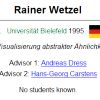| |
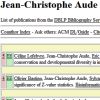 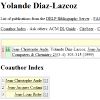  
Jean-Christophe Aude,
Yolande Diaz-Lazcoz,
Jean-Jacques Codani and
Jean-Loup Risler. Applications of the Pyramidal Clustering Method to Biological Objects. In CC, Vol. 23(3-4):303-315, 1999.
Keywords: from distances, phylogenetic network, phylogeny, Program Pyramids, pyramid, reconstruction, software, visualization.
Note: http://dx.doi.org/10.1016/S0097-8485(99)00006-6.
|
|
| |
|
| |
|
| |
  
Andreas W. M. Dress,
Daniel H. Huson and
Vincent Moulton. Analyzing and visualizing distance data using SplitsTree. In DAM, Vol. 71(1):95-109, 1996.
Keywords: abstract network, from distances, phylogenetic network, phylogeny, Program SplitsTree, software, split network, visualization.
Note: http://bibiserv.techfak.uni-bielefeld.de/splits/splits.pdf.
|
|
| |
 
Andreas W. M. Dress and
Daniel H. Huson. Constructing splits graphs. In TCBB, Vol. 1(3):109-115, 2004.
Keywords: abstract network, circular split system, from trees, phylogenetic network, phylogeny, Program SplitsTree, reconstruction, split network, visualization.
Note: http://scilib.kiev.ua/ieee/tcbb/2004/03/n3/n0109.pdf.
Toggle abstract
"Phylogenetic trees correspond one-to-one to compatible systems of splits and so splits play an important role in theoretical and computational aspects of phylogeny. Whereas any tree reconstruction method can be thought of as producing a compatible system of splits, an increasing number of phylogenetlc algorithms are available that compute split systems that are not necessarily compatible and, thus, cannot always be represented by a tree. Such methods include the split decomposition, Neighbor-Net, consensus networks, and the Z-closure method. A more general split system of this kind can be represented graphically by a so-called splits graph, which generalizes the concept of a phylogenetic tree. This paper addresses the problem of computing a splits graph for a given set of splits. We have implemented all presented algorithms in a new program called SplitsTree4. © 2004 IEEE."
|
|
| |
 
Philippe Gambette and
Daniel H. Huson. Improved Layout of Phylogenetic Networks. In TCBB, Vol. 5(3):472-479, 2008.
Keywords: abstract network, heuristic, phylogenetic network, phylogeny, Program SplitsTree, software, split network, visualization.
Note: http://hal-lirmm.ccsd.cnrs.fr/lirmm-00309694/en/.
Toggle abstract
"Split networks are increasingly being used in phylogenetic analysis. Usually, a simple equal-angle algorithm is used to draw such networks, producing layouts that leave much room for improvement. Addressing the problem of producing better layouts of split networks, this paper presents an algorithm for maximizing the area covered by the network, describes an extension of the equal-daylight algorithm to networks, looks into using a spring embedder, and discusses how to construct rooted split networks. © 2008 IEEE."
|
|
| |
|
| |
 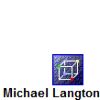   
Katharina Huber,
Michael Langton,
David Penny,
Vincent Moulton and
Mike Hendy. Spectronet: A package for computing spectra and median networks. In ABIO, Vol. 1(3):159-161, 2004.
Keywords: from splits, median network, phylogenetic network, phylogeny, Program Spectronet, software, split, visualization.
Note: http://citeseer.ist.psu.edu/631776.html.
Toggle abstract
Spectronet is a package that uses various methods for exploring and visualising complex evolutionary signals. Given an alignment in NEXUS format, the package works by computing a collection of weighted splits or bipartitions of the taxa and then allows the user to interactively analyse the resulting collection using tools such as Lento-plots and median networks. The package is highly interactive and available for PCs.
|
|
| |
|
| |
    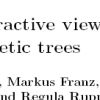 
Daniel H. Huson,
Daniel C. Richter,
Christian Rausch,
Tobias Dezulian,
Markus Franz and
Regula Rupp. Dendroscope: An interactive viewer for large phylogenetic trees. In BMCB, Vol. 8:460, 2007.
Keywords: phylogeny, Program Dendroscope, software, visualization.
Note: http://dx.doi.org/10.1186/1471-2105-8-460, slides available at http://www.newton.cam.ac.uk/webseminars/pg+ws/2007/plg/plgw01/0903/huson/, software freely available from http://www.dendroscope.org.
Toggle abstract
"Background: Research in evolution requires software for visualizing and editing phylogenetic trees, for increasingly very large datasets, such as arise in expression analysis or metagenomics, for example. It would be desirable to have a program that provides these services in an effcient and user-friendly way, and that can be easily installed and run on all major operating systems. Although a large number of tree visualization tools are freely available, some as a part of more comprehensive analysis packages, all have drawbacks in one or more domains. They either lack some of the standard tree visualization techniques or basic graphics and editing features, or they are restricted to small trees containing only tens of thousands of taxa. Moreover, many programs are diffcult to install or are not available for all common operating systems. Results: We have developed a new program, Dendroscope, for the interactive visualization and navigation of phylogenetic trees. The program provides all standard tree visualizations and is optimized to run interactively on trees containing hundreds of thousands of taxa. The program provides tree editing and graphics export capabilities. To support the inspection of large trees, Dendroscope offers a magnification tool. The software is written in Java 1.4 and installers are provided for Linux/Unix, MacOS X and Windows XP. Conclusion: Dendroscope is a user-friendly program for visualizing and navigating phylogenetic trees, for both small and large datasets. © 2007 Huson et al; licensee BioMed Central Ltd."
|
|
| |
|
| |
 
Tobias Kloepper and
Daniel H. Huson. Drawing explicit phylogenetic networks and their integration into SplitsTree. In BMCEB, Vol. 8(22), 2008.
Keywords: explicit network, phylogenetic network, phylogeny, Program SplitsTree, software, split network, visualization.
Note: http://dx.doi.org/10.1186/1471-2148-8-22.
Toggle abstract
"Background. SplitsTree provides a framework for the calculation of phylogenetic trees and networks. It contains a wide variety of methods for the import/export, calculation and visualization of phylogenetic information. The software is developed in Java and implements a command line tool as well as a graphical user interface. Results. In this article, we present solutions to two important problems in the field of phylogenetic networks. The first problem is the visualization of explicit phylogenetic networks. To solve this, we present a modified version of the equal angle algorithm that naturally integrates reticulations into the layout process and thus leads to an appealing visualization of these networks. The second problem is the availability of explicit phylogenetic network methods for the general user. To advance the usage of explicit phylogenetic networks by biologists further, we present an extension to the SplitsTree framework that integrates these networks. By addressing these two problems, SplitsTree is among the first programs that incorporates implicit and explicit network methods together with standard phylogenetic tree methods in a graphical user interface environment. Conclusion. In this article, we presented an extension of SplitsTree 4 that incorporates explicit phylogenetic networks. The extension provides a set of core classes to handle explicit phylogenetic networks and a visualization of these networks. © 2008 Kloepper and Huson; licensee BioMed Central Ltd."
|
|
| |

Daniel H. Huson. Drawing Rooted Phylogenetic Networks. In TCBB, Vol. 6(1):103-109, 2009.
Keywords: explicit network, phylogenetic network, phylogeny, Program Dendroscope, Program SplitsTree, visualization.
Note: http://dx.doi.org/10.1109/TCBB.2008.58.
Toggle abstract
"The evolutionary history of a collection of species is usually represented by a phylogenetic tree. Sometimes, phylogenetic networks are used as a means of representing reticulate evolution or of showing uncertainty and incompatibilities in evolutionary datasets. This is often done using unrooted phylogenetic networks such as split networks, due in part, to the availability of software (SplitsTree) for their computation and visualization. In this paper we discuss the problem of drawing rooted phylogenetic networks as cladograms or phylograms in a number of different views that are commonly used for rooted trees. Implementations of the algorithms are available in new releases of the Dendroscope and SplitsTree programs. © 2006 IEEE."
|
|
| |
  
Gabriel Cardona,
Francesc Rosselló and
Gabriel Valiente. Extended Newick: It is Time for a Standard Representation. In BMCB, Vol. 9:532, 2008.
Keywords: evaluation, explicit network, phylogenetic network, Program Bio PhyloNetwork, Program Dendroscope, Program NetGen, Program PhyloNet, Program SplitsTree, Program TCS, visualization.
Note: http://bioinfo.uib.es/media/uploaded/bmc-2008-enewick-sub.pdf.
|
|
| |

Mark A. Ragan. Trees and networks before and after Darwin. In Biology Direct, Vol. 4(43), 2009.
Keywords: abstract network, explicit network, phylogenetic network, phylogeny, survey, visualization.
Note: http://dx.doi.org/10.1186/1745-6150-4-43.
Toggle abstract
"It is well-known that Charles Darwin sketched abstract trees of relationship in his 1837 notebook, and depicted a tree in the Origin of Species (1859). Here I attempt to place Darwin's trees in historical context. By the mid-Eighteenth century the Great Chain of Being was increasingly seen to be an inadequate description of order in nature, and by about 1780 it had been largely abandoned without a satisfactory alternative having been agreed upon. In 1750 Donati described aquatic and terrestrial organisms as forming a network, and a few years later Buffon depicted a network of genealogical relationships among breeds of dogs. In 1764 Bonnet asked whether the Chain might actually branch at certain points, and in 1766 Pallas proposed that the gradations among organisms resemble a tree with a compound trunk, perhaps not unlike the tree of animal life later depicted by Eichwald. Other trees were presented by Augier in 1801 and by Lamarck in 1809 and 1815, the latter two assuming a transmutation of species over time. Elaborate networks of affinities among plants and among animals were depicted in the late Eighteenth and very early Nineteenth centuries. In the two decades immediately prior to 1837, so-called affinities and/or analogies among organisms were represented by diverse geometric figures. Series of plant and animal fossils in successive geological strata were represented as trees in a popular textbook from 1840, while in 1858 Bronn presented a system of animals, as evidenced by the fossil record, in a form of a tree. Darwin's 1859 tree and its subsequent elaborations by Haeckel came to be accepted in many but not all areas of biological sciences, while network diagrams were used in others. Beginning in the early 1960s trees were inferred from protein and nucleic acid sequences, but networks were re-introduced in the mid-1990s to represent lateral genetic transfer, increasingly regarded as a fundamental mode of evolution at least for bacteria and archaea. In historical context, then, the Network of Life preceded the Tree of Life and might again supersede it. Reviewers: This article was reviewed by Eric Bapteste, Patrick Forterre and Dan Graur. © 2009 Ragan; licensee BioMed Central Ltd."
|
|
| |
   
Miguel Arenas,
Mateus Patricio,
David Posada and
Gabriel Valiente. Characterization of Phylogenetic Networks with NetTest. In BMCB, Vol. 11:268, 2010.
Keywords: explicit network, galled tree, phylogenetic network, Program NetTest, software, time consistent network, tree sibling network, tree-child network, visualization.
Note: http://dx.doi.org/10.1186/1471-2105-11-268, software available at http://darwin.uvigo.es/software/nettest/.
Toggle abstract
"Background: Typical evolutionary events like recombination, hybridization or gene transfer make necessary the use of phylogenetic networks to properly depict the evolution of DNA and protein sequences. Although several theoretical classes have been proposed to characterize these networks, they make stringent assumptions that will likely not be met by the evolutionary process. We have recently shown that the complexity of simulated networks is a function of the population recombination rate, and that at moderate and large recombination rates the resulting networks cannot be categorized. However, we do not know whether these results extend to networks estimated from real data.Results: We introduce a web server for the categorization of explicit phylogenetic networks, including the most relevant theoretical classes developed so far. Using this tool, we analyzed statistical parsimony phylogenetic networks estimated from ~5,000 DNA alignments, obtained from the NCBI PopSet and Polymorphix databases. The level of characterization was correlated to nucleotide diversity, and a high proportion of the networks derived from these data sets could be formally characterized.Conclusions: We have developed a public web server, NetTest (freely available from the software section at http://darwin.uvigo.es), to formally characterize the complexity of phylogenetic networks. Using NetTest we found that most statistical parsimony networks estimated with the program TCS could be assigned to a known network class. The level of network characterization was correlated to nucleotide diversity and dependent upon the intra/interspecific levels, although no significant differences were detected among genes. More research on the properties of phylogenetic networks is clearly needed. © 2010 Arenas et al; licensee BioMed Central Ltd."
|
|
| |
  
Andreas Spillner,
Binh T. Nguyen and
Vincent Moulton. Constructing and Drawing Regular Planar Split Networks. In TCBB, Vol. 9(2):395-407, 2012.
Keywords: abstract network, from splits, phylogenetic network, phylogeny, reconstruction, visualization.
Note: slides and presentation available at http://www.newton.ac.uk/programmes/PLG/seminars/062111501.html.
Toggle abstract
"Split networks are commonly used to visualize collections of bipartitions, also called splits, of a finite set. Such collections arise, for example, in evolutionary studies. Split networks can be viewed as a generalization of phylogenetic trees and may be generated using the SplitsTree package. Recently, the NeighborNet method for generating split networks has become rather popular, in part because it is guaranteed to always generate a circular split system, which can always be displayed by a planar split network. Even so, labels must be placed on the "outside" of the network, which might be problematic in some applications. To help circumvent this problem, it can be helpful to consider so-called flat split systems, which can be displayed by planar split networks where labels are allowed on the inside of the network too. Here, we present a new algorithm that is guaranteed to compute a minimal planar split network displaying a flat split system in polynomial time, provided the split system is given in a certain format. We will also briefly discuss two heuristics that could be useful for analyzing phylogeographic data and that allow the computation of flat split systems in this format in polynomial time. © 2006 IEEE."
|
|
| |
 
Daniel H. Huson and
Celine Scornavacca. Dendroscope 3: An Interactive Tool for Rooted Phylogenetic Trees and Networks. In Systematic Biology, Vol. 61(6):1061-1067, 2012.
Keywords: from rooted trees, from triplets, phylogenetic network, phylogeny, Program Dendroscope, reconstruction, software, visualization.
Toggle abstract
"Dendroscope 3 is a new program for working with rooted phylogenetic trees and networks. It provides a number of methods for drawing and comparing rooted phylogenetic networks, and for computing them from rooted trees. The program can be used interactively or in command-line mode. The program is written in Java, use of the software is free, and installers for all 3 major operating systems can be downloaded from www.dendroscope.org. [Phylogenetic trees; phylogenetic networks; software.] © 2012 The Author(s)."
|
|
| |
|
| |
  
Celine Scornavacca,
Paprotny Wojciech,
Vincent Berry and
Vincent Ranwez. Representing a set of reconciliations in a compact way. In JBCB, Vol. 11(2):1250025, 2013.
Keywords: duplication, explicit network, from network, from rooted trees, from species tree, phylogeny, Program GraphDTL, Program TERA, visualization.
Note: http://hal-lirmm.ccsd.cnrs.fr/lirmm-00818801.
Toggle abstract
"Comparative genomic studies are often conducted by reconciliation analyses comparing gene and species trees. One of the issues with reconciliation approaches is that an exponential number of optimal scenarios is possible. The resulting complexity is masked by the fact that a majority of reconciliation software pick up a random optimal solution that is returned to the end-user. However, the alternative solutions should not be ignored since they tell different stories that parsimony considers as viable as the output solution. In this paper, we describe a polynomial space and time algorithm to build a minimum reconciliation graph-a graph that summarizes the set of all most parsimonious reconciliations. Amongst numerous applications, it is shown how this graph allows counting the number of non-equivalent most parsimonious reconciliations. © 2013 Imperial College Press."
|
|
| |
    
François Chevenet,
Jean-Philippe Doyon,
Celine Scornavacca,
Edwin Jacox,
Emmanuelle Jousselin and
Vincent Berry. SylvX: a viewer for phylogenetic tree reconciliations. In BIO, Vol. 32(4):608-610, 2016.
Keywords: duplication, explicit network, from rooted trees, from species tree, lateral gene transfer, loss, phylogenetic network, phylogeny, Program SylvX, software, visualization.
Note: https://www.researchgate.net/profile/Emmanuelle_Jousselin/publication/283446016_SylvX_a_viewer_for_phylogenetic_tree_reconciliations/links/5642146108aec448fa621efa.pdf.
|
|
| |
   
Klaus Schliep,
Alastair J. Potts,
David A. Morrison and
Guido W. Grimm. Intertwining phylogenetic trees and networks. In Methods in Ecology and Evolution, Vol. 8(10):1212-1220, 2017.
Keywords: abstract network, from network, from unrooted trees, phylogenetic network, phylogeny, split network, visualization.
Note: http://dx.doi.org/10.1111/2041-210X.12760.
|
|
| |
|
|
|
 - forked on GitHub.
- forked on GitHub.



















































